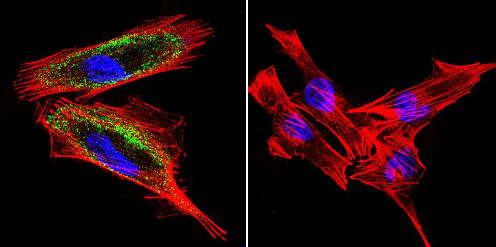
Immunocytochemistry/Immunofluorescence analysis of Hydrogen Potassium ATPase Beta shows staining in A2058 cells. Hydrogen Potassium ATPase Beta staining (green), F-Actin staining with Phalloidin (red) and nuclei with DAPI (blue) is shown. Cells were grown on chamber slides and fixed with formaldehyde prior to staining. Cells were incubated without (control) or with ab2866 (1:100) overnight at 4°C, washed with PBS and incubated with a DyLight-488 conjugated goat anti-mouse secondary antibody. Images were taken at 60X magnification.
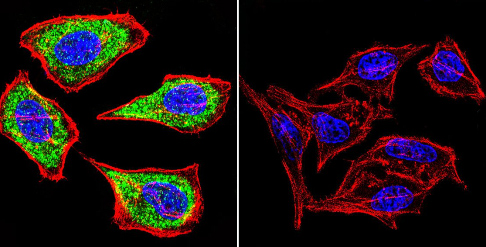
Immunocytochemistry/Immunofluorescence analysis of Hydrogen Potassium ATPase Beta shows staining in HeLa cells. Hydrogen Potassium ATPase Beta staining (green), F-Actin staining with Phalloidin (red) and nuclei with DAPI (blue) is shown. Cells were grown on chamber slides and fixed with formaldehyde prior to staining. Cells were incubated without (control) or with ab2866 (1:200) overnight at 4°C, washed with PBS and incubated with a DyLight-488 conjugated goat anti-mouse secondary antibody. Images were taken at 60X magnification.
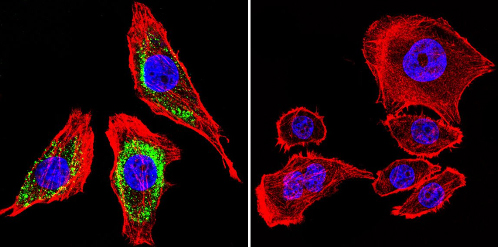
Immunocytochemistry/Immunofluorescence analysis of Hydrogen Potassium ATPase Beta shows staining in U251 cells. Hydrogen Potassium ATPase Beta staining (green), F-Actin staining with Phalloidin (red) and nuclei with DAPI (blue) is shown. Cells were grown on chamber slides and fixed with formaldehyde prior to staining. Cells were incubated without (control) or with ab2866 (1:100) overnight at 4°C, washed with PBS and incubated with a DyLight-488 conjugated goat anti-mouse secondary antibody. Images were taken at 60X magnification.
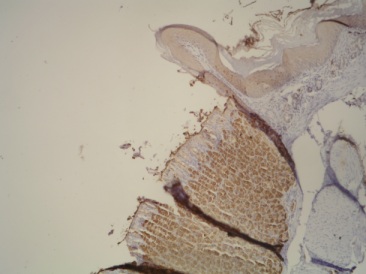
ab2866 diluted 1/200 on paraffin wax embedded section of gerbil stomach tissue.
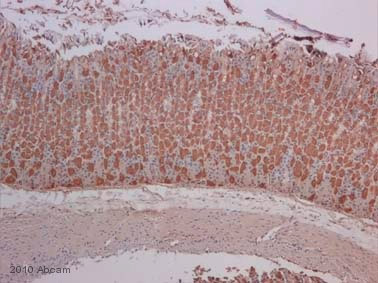
ab2866 staining Hydrogen Potassium ATPase Beta in mouse stomach tissue sections by IHC-P (formaldehyde-fixed paraffin-embedded sections). Tissue samples were fixed with formaldehyde and blocked with 4% serum for 30 minutes at 25°C; antigen retrival was by heat mediation in Citrate buffer. The sample was incubated with primary antibody (1/2500 in 4% serum) at 4°C for 16 hours. Ab6788 (1/500)was used as secondary antibody.See Abreview
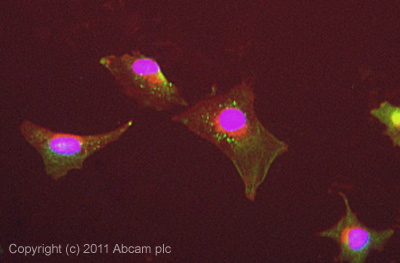
ICC/IF image of ab2866 stained HeLa cells. The cells were 4% formaldehyde fixed (10 min) and then incubated in 1%BSA / 10% normal goat serum / 0.3M glycine in 0.1% PBS-Tween for 1h to permeabilise the cells and block non-specific protein-protein interactions. The cells were then incubated with the antibody (ab2866, 10µg/ml) overnight at +4°C. The secondary antibody (green) was ab96879, DyLight® 488 goat anti-mouse IgG (H+L) used at a 1/250 dilution for 1h.Alexa Fluor® 594 WGA was used to label plasma membranes (red) at a 1/200 dilution for 1h. DAPI was used to stain the cell nuclei (blue) at a concentration of 1.43µM.
 used under the same conditions. Acquisition of >5,000 events was performed. This antibody gave a positive signal in LoVo cells fixed with 4% paraformaldehyde/permeabilized in 0.1% PBS-Tween used under the same conditions.](http://www.bioprodhub.com/system/product_images/ab_products/2/sub_3/5941_Hydrogen-Potassium-ATPase-Beta-Primary-antibodies-ab2866-6.jpg)
Overlay histogram showing LoVo cells stained with ab2866 (red line). The cells were fixed with 80% methanol (5 min) and then permeabilized with 0.1% PBS-Tween for 20 min. The cells were then incubated in 1x PBS / 10% normal goat serum / 0.3M glycine to block non-specific protein-protein interactions followed by the antibody (ab2866, 1/50 dilution) for 30 min at 22°C. The secondary antibody used was DyLight® 488 goat anti-mouse IgG (H+L) (ab96879) at 1/500 dilution for 30 min at 22°C. Isotype control antibody (black line) was mouse IgG1 [ICIGG1](ab91353, 2µg/1x106 cells) used under the same conditions. Acquisition of >5,000 events was performed. This antibody gave a positive signal in LoVo cells fixed with 4% paraformaldehyde/permeabilized in 0.1% PBS-Tween used under the same conditions.
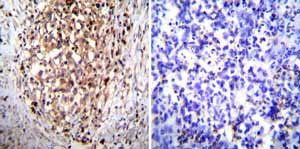
Immunohistochemistry was performed on both normal and cancer biopsies of deparaffinized Human gastric carcinoma tissues. To expose target proteins heat induced antigen retrieval was performed using 10mM sodium citrate (pH6.0) buffer microwaved for 8-15 minutes. Following antigen retrieval tissues were blocked in 3% BSA-PBS for 30 minutes at room temperature. Tissues were then probed at a dilution of 1:200 with a mouse monoclonal antibody recognizing Hydrogen/Potassium ATPase beta ab2866 or without primary antibody (negative control) overnight at 4°C in a humidified chamber. Tissues were washed extensively with PBST and endogenous peroxidase activity was quenched with a peroxidase suppressor. Detection was performed using a biotin-conjugated secondary antibody and SA-HRP followed by colorimetric detection using DAB. Tissues were counterstained with hematoxylin and prepped for mounting.
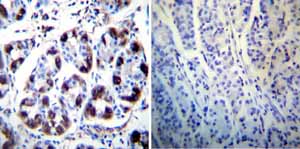
Immunohistochemistry was performed on both normal and cancer biopsies of deparaffinized Human stomach tissue tissues. To expose target proteins heat induced antigen retrieval was performed using 10mM sodium citrate (pH6.0) buffer microwaved for 8-15 minutes. Following antigen retrieval tissues were blocked in 3% BSA-PBS for 30 minutes at room temperature. Tissues were then probed at a dilution of 1:200 with a mouse monoclonal antibody recognizing Hydrogen/Potassium ATPase beta ab2866 or without primary antibody (negative control) overnight at 4°C in a humidified chamber. Tissues were washed extensively with PBST and endogenous peroxidase activity was quenched with a peroxidase suppressor. Detection was performed using a biotin-conjugated secondary antibody and SA-HRP followed by colorimetric detection using DAB. Tissues were counterstained with hematoxylin and prepped for mounting.






 used under the same conditions. Acquisition of >5,000 events was performed. This antibody gave a positive signal in LoVo cells fixed with 4% paraformaldehyde/permeabilized in 0.1% PBS-Tween used under the same conditions.](http://www.bioprodhub.com/system/product_images/ab_products/2/sub_3/5941_Hydrogen-Potassium-ATPase-Beta-Primary-antibodies-ab2866-6.jpg)

